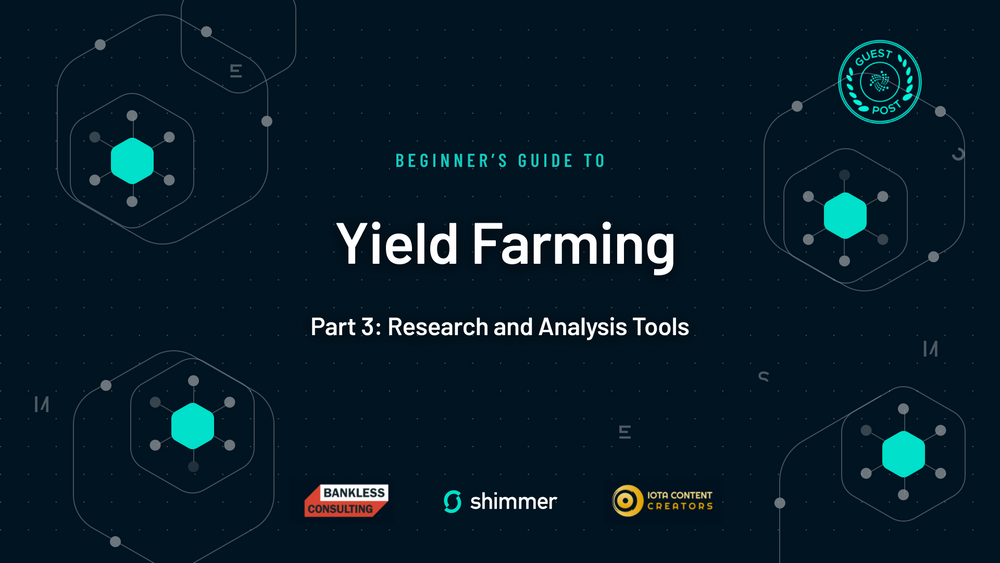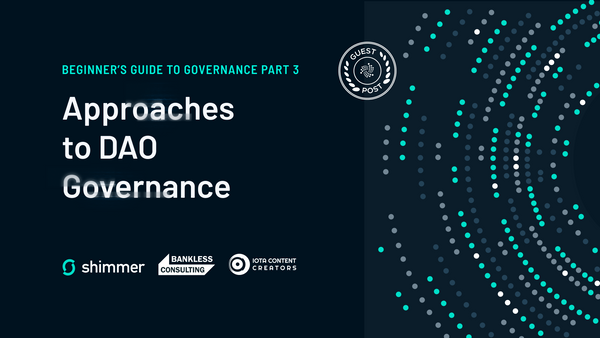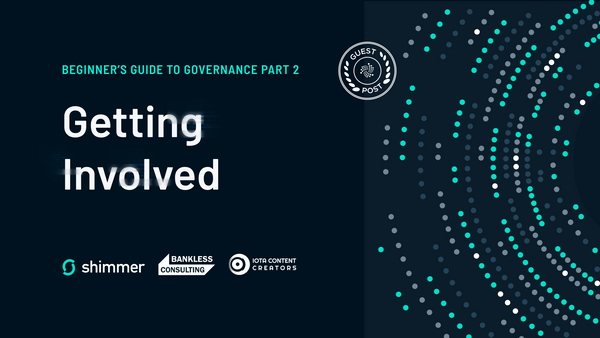Beginner’s Guide to Yield Farming Part 3
Research and Analysis Tools
TL;DR:
The final part of our introduction to yield farming discusses various methodologies and tools for evaluating and assessing decentralized finance (DeFi) protocols. It highlights four methods that individuals can use to assess a protocol's safety: Total Value Locked (TVL), the Lindy Effect, protocol forks, and insurance rates. It then introduces three tools that can aid in evaluating DeFi protocols: DeFi Llama, Dune Analytics, and Nansen.
In the previous part of this beginner's guide to yield farming, we covered the five most popular current methods. But how to choose which is the right protocol for your decentralized finance activities? Rather than solely relying on third-party tools to assess a protocol, you can also employ some relatively simple methodologies yourself.
Although most of us can’t scrutinize a protocol’s smart contracts to make sure they are safe, there are a few basic methods for obtaining a quick assessment on your own.
- Total Value Locked (TVL): This number represents the overall value of assets deposited in a DeFi project. DeFi assets include rewards and interest, coming from lending, staking, and liquidity pools. TVL can also be noted specifically for protocol staking. In this case, it represents the amount of assets deposited by liquidity providers.
- The Lindy Effect: This postulates that the longer a protocol has been active without being hacked, the safer it is. The idea is that these protocols are like honeypots to hackers, who will try to attack them to drain the funds using every weapon in their armory. If they’ve been unsuccessful for a significant amount of time, you can have increased confidence that they won’t be able to any time soon. An important note here is that the Lindy Effect applies to a specific version of a protocol. As soon as revisions, updates or new features are applied, the timer resets!
- Protocol Forks: It is common for a new network to utilize a previous, proven platform or protocol in the form of a clean fork. The contracts involved have likely already been battle-tested and evolved into a stable, trusted version. If the fork really is clean, you may not need to rely as much on TVL or the Lindy Effect for the new protocol. Instead, you can refer to the original protocol. However, be careful! If new features or revisions have been included, they must be fully audited, so perhaps it would be best to wait before deploying significant capital in such a protocol.
- Insurance Rates: If you want additional peace of mind after using the methods above and even some of the tools that follow, you can purchase insurance. One such product is offered by Nexus Mutual, which works like a traditional insurance company. It offers products to insure against protocol failure and even against ETH slashing risk. You pay a premium for the coverage and submit a claim for reimbursement in case of failure. Even if you decide not to purchase an insurance policy, there is valuable information you can obtain just by comparing the premiums required for different protocol policies. For example, comparing premiums can be an effective way of comparing the relative risk levels of different protocols you are considering: the higher the premium, the more risky the protocol. If there has been a recent wallet or platform hack, you can expect to pay more for insurance.
While it’s important to have a basic idea about how to evaluate a protocol on your own, inevitably you will need to do a deeper dive. Fortunately, there are some great tools out there that can make this task much easier for you. Below we present three such tools and their respective features.

DeFi Llama
Defi Llama (DefiLlama.com) is a user-friendly data analytics platform and aggregator. It provides real-time, comprehensive data, rankings, and insights into DeFi ecosystem projects. By serving as a valuable resource for users, investors, and researchers, it empowers them to make informed decisions by allowing them to explore and track various DeFi protocols and their associated metrics.
DeFi Llama’s key features are:
- DeFi Protocol Tracking: Defi Llama tracks and aggregates data from a wide range of DeFi protocols, including lending platforms, decentralized exchanges (DEXs), yield farming projects, stablecoins, and more. It provides up-to-date information on key metrics such as total value locked (TVL), trading volume, liquidity, token prices, and various performance indicators. DeFi Llama key features:
- TVL Rankings: As was mentioned earlier, total value locked (TVL) is a widely used metric in the DeFi space, representing the total amount of assets locked within a specific protocol. Defi Llama ranks many DeFi protocols based on their TVL, allowing users to assess the prominence and popularity of different DeFi projects.
- Protocol Details and Analytics: Defi Llama provides detailed information about many tracked protocols, including key statistics, tokenomics, supported assets, governance mechanisms, and even historical data. Users can explore various charts, graphs, and analytics to gain insights into a protocol’s performance and growth over time.
- Portfolio Tracking: Users can track their personal portfolio’s value in DeFi Llama, even across multiple protocols and tokens. This is done by first connecting one’s wallet to Defi Llama. The platform then aggregates and displays the portfolio’s value, asset allocation, and historical performance, offering a complete, consolidated view of their holdings.
- News and Updates: Defi Llama includes a news section that provides the latest updates, announcements, and insights from the DeFi space. Users can stay informed about important developments, new projects, partnerships, and regulatory changes affecting the DeFi ecosystem.
- API Access: Lastly, Defi Llama offers an API for developers and analysts who want to access and utilize DeFi data programmatically. This allows integration with other applications, and programmers can build custom tools using the provided data.

Dune Analytics
Dune Analytics (Dune.com/home) is a powerful, open-source and user-friendly data analytics platform specifically designed for blockchain and decentralized applications (dApps). It allows users to explore, query, and leverage on-chain data from various blockchain networks. This enables them to gain deep insights into specific activities and trends, empowering them to make data-driven decisions. Its user-friendly interface, customizable dashboards, and collaborative features make it an extremely valuable tool. Here are some of Dune’s key features:
- Data Exploration and Querying: Dune Analytics provides a user-friendly interface that allows users to explore and query on-chain data from popular blockchain networks, such as Ethereum. Users can write SQL-like queries to extract specific data points, filter results, and perform calculations on the blockchain data directly.
- Customizable Dashboards and Visualizations: Users can create personalized dashboards and visualizations using the data they pull from Dune Analytics. The platform offers several different visualization options, including charts, graphs, tables, and even heatmaps, allowing users to present and analyze data in a visually appealing, intuitive manner.
- Public and Shared Dashboards: Dune Analytics allows users to share their dashboards and queries publicly if they so desire, making it a collaborative platform for the crypto community. Users can discover and explore dashboards created by others to learn from their analysis. They can even fork and modify those dashboards to suit their own needs.
- Integration with DeFi Protocols: Dune Analytics has deep integrations with various DeFi protocols, enabling users to access and analyze available data. This includes lending platforms, decentralized exchanges (DEXs), yield farming projects, liquidity pools, and more. Users can learn about the trading volumes, liquidity, user activity, and other important metrics of these protocols.
- Community and Learning Resources: Dune Analytics intends to build a strong community of data analysts, developers, and enthusiasts. Users can interact with other like-minded individuals through discussions, forums, and collaborative projects. The platform also provides learning resources, tutorials, and documentation to help people get started with data analysis and methods of querying the blockchain.
- API Access: Similar to Defi Llama, Dune Analytics offers an API that allows developers to programmatically access and integrate blockchain data into their own applications, products, or services. This enables developers to build custom analytics tools, data-driven dApps, or automated workflows using the plethora of on-chain data available.

Nansen
Nansen.ai (nansen.ai) is an advanced analytics platform that provides in-depth insights and data analysis for the Ethereum blockchain. It focuses on extracting valuable on-chain data and providing actionable intelligence for users by helping them to identify market trends. Here are some key features, but note that there are fees associated with the use of this platform:
- On-Chain Data Analytics: As mentioned, Nansen.ai offers comprehensive on-chain data analytics for the Ethereum network. It collects and processes large amounts of data from the blockchain, including transaction history, token transfers, smart contract interactions, and even user behaviors. This data is then analyzed and presented in a user-friendly format for easy exploration.
- Token and Address Tracking: Users can track and monitor specific tokens or addresses using Nansen.ai. This feature allows users to gain insights into token flows, track specific wallet balances, and understand the activity and trading patterns of those addresses.
- Transaction Clustering and Labeling: Nansen.ai employs advanced algorithms to cluster and label Ethereum transactions. This helps users identify the different types of addresses (such as exchanges, liquidity providers, or smart contracts) and understand the relationships and interactions between them. It provides valuable context and helps to identify trends, whale activity, market movements, etc.
- Whale and Token Holder Insights: Nansen.ai offers insights into the activities of large Ethereum holders, also known as “whales.” Users can track whale movements, analyze their trading patterns, and learn about their accumulation or distribution behaviors. This information can be valuable for understanding market trends and identifying possible investment opportunities.
- DeFi Insights: Nansen.ai provides specific analytics and insights for decentralized finance (DeFi) protocols. Users can explore the activities and behaviors within popular DeFi platforms, such as lending, decentralized exchanges, yield farming, and more. This helps users identify trends, assess the popularity of specific protocols, and make data-driven decisions in the DeFi space.
- Social Signals and Sentiment Analysis: Nansen.ai incorporates social signals and sentiment analysis by analyzing on-chain data associated with social platforms, forums, and communities. This feature provides additional context and market sentiment indicators, helping users to understand market dynamics and sentiment around specific projects or tokens.
- API Access: Like the other tool mentioned, Nansen.ai also offers an API that allows developers and researchers to programmatically access and integrate on-chain data into their own applications, models, or research projects. This enables developers to build custom data-driven tools, conduct further analysis, or incorporate Nansen.ai data into their workflows. Programmers rely on these types of integrations.
You should now have a good grasp of the many opportunities that DeFi offers in the realm of yield farming. There is a wide range of strategies to employ that can satisfy investors of different risk levels and APY targets. Even though some may be relatively safe, it’s still important that you do your own research and fully understand the risks involved. Luckily, there are plenty of tools that can assist you in this goal, so use them wisely!
Beginner’s Guide to Yield Farming
Part 1: Seeding Success: The Power of Yield Farming in Crypto Networks
Part 2: Top Five Methods of Yield Farming
Part 3: Research and Analysis Tools
Also in this series
Beginner's Guide to Crypto Wallets
Beginners Guide to DEX vs. CEX
Beginner's Guide to DeFi Lending & Borrowing
Beginner's Guide to Yield Farming



